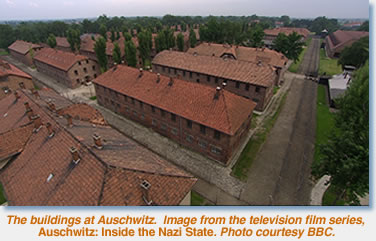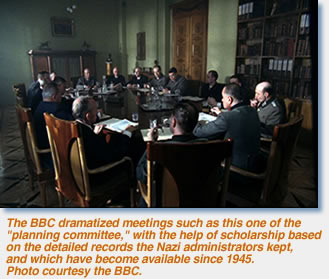Editor’s Note: We print below a report on a documentary film series on Auschwitz that was produced by KCET-TV of Los Angeles and the BBC, and which is scheduled to be broadcast on the PBS network in January 2005 (check with local stations for exact broadcast dates and times). While providing a brief preview of the series, the article also discusses the role played by historians who were consulted by the producers to ensure historical authenticity. The film series is the focus of a "Vital Issues" session in the annual conference of the National Conference for the Social Studies, scheduled to be held November 19–21, 2004, in Baltimore.
Instead of just shocking the viewers and eliciting an emotional response, the series will ask searching questions about human behavior—among the perpetrators, those who let them act, and those who suffered their evil attentions." With that concise statement, David Cesarani, professor of 20th-century Jewish history and culture at the University of Southampton (England), describes Auschwitz: Inside the Nazi State, a six-part documentary that will air on PBS in January 2005, the 60th anniversary of the liberation of the Nazi camp.
Cesarani is one of several historians who have actively consulted on the series, which is coproduced by KCET/Hollywood and the BBC’s History Unit. The BBC’s Laurence Rees, producer of three major series on World War II, is the executive producer. Like Cesarani, Rees suggests this series is different from previous documentaries about the Holocaust: "What has not been done on television is an attempt to explore the decision-making process of the Nazis and to try to make people understand how on earth it was possible that people actually sat down in various stages and made key decisions to end up murdering six million men, women, and children."
A veteran of historical documentaries, Rees credits the major role historians have played in the production of Auschwitz: Inside the Nazi State. He said, “From the very first, we knew that if we were going to do this, it was absolutely vital with this subject above all other subjects to insure that we have a level of scholarly and academic backup and consultative help that insures that as far as possible what we’re saying is accurate and correct.”
To provide that support, Rees assembled a team of world-renowned experts on the Holocaust. In addition to Cesarani, the advisers include Christopher Browning, Frank Porter Graham Professor at the University of North Carolina at Chapel Hill and recent author of The Origins of the Final Solution, part of Yad Vashem’s multivolume history of the Holocaust; Ian Kershaw, one of the world’s leading experts on Hitler and the Third Reich and script consultant on the BBC series, Nazis: A Warning from History; and Robert Jan van Pelt, the worldwide expert on the architecture, culture, and plans for Auschwitz and coauthor of Auschwitz 1270 to the Present. Other advisers included Douglas Greenberg, president and CEO of the Survivors of the Shoah Visual History Foundation; David G. Marwell, director of the Museum of Jewish Heritage—A Living Memorial to the Holocaust; and Margot Stern Strom, executive director of Facing History and Ourselves.
 Browning, who serves as senior consulting scholar for the series, notes that it “incorporates the very latest research. We are taking extreme care with the scholarly integrity of the series while simultaneously distilling and disseminating this scholarship for a wider audience.” He added, “In my experience, this is very different from the attitude of many filmmakers who put their presumptions about popular appeal and marketability before scholarly content.”
Browning, who serves as senior consulting scholar for the series, notes that it “incorporates the very latest research. We are taking extreme care with the scholarly integrity of the series while simultaneously distilling and disseminating this scholarship for a wider audience.” He added, “In my experience, this is very different from the attitude of many filmmakers who put their presumptions about popular appeal and marketability before scholarly content.”
The scholars worked with the producers to develop the overall structure for the series and the content of each program. They also recognized the need to introduce younger audiences to the history of the Holocaust and therefore the need to make the series different from most documentaries on the subject, which primarily appeal to older audiences. The team addressed these challenges by developing a fundamental conceptual framework for the series, incorporating the most up-to-date research, and utilizing contemporary production techniques. As Kershaw observed, "The totality of the Holocaust will be explored through this prism in ways never before seen on television. The series is different from anything that has previously been attempted."
The series has been specifically designed in six parts to provide broad insight into how the Holocaust came to be, how it functioned, and the personnel who planned, managed, and turned Auschwitz into the largest mechanized killing field in the history of the world. The six episodes unfold chronologically, but the series also moves laterally to examine the political, social, and economic evolution of Auschwitz as well as the response of Europe and the Allies to Nazi Germany.
In the first instance, the producers and scholars viewed Auschwitz as a metaphor. They believe the story of Auschwitz reveals the broader contours of the whole Nazi state. "I immediately saw the value of focusing on Auschwitz as a paradigm for the Holocaust and wider Nazi inhumanity," Kershaw said. "Through this lens, it is more possible than in other more general treatments of the Holocaust to understand how the unimaginable could become reality."
Rees added, "If you like, it’s a biography not of a person but of a physical place from May 1940 through to January 1945, and rather like a person, it goes through whole different stages of evolution. We tie those stages of evolution into the broader context of why they’re deciding to set up death camps in Poland, why they’re deciding to start shooting people in pits in the east, why they’re deciding to deport Jews from their allies."
The series benefited enormously from the opening of archives in the former Soviet bloc. After liberating the camp, Soviet troops had collected numerous plans, memos, meeting minutes, photos, and other records from Auschwitz, and these became available after the dissolution of the Soviet Union. "There’s been a whole raft of documents that have come out of the Soviet Union that scholars have been studying now for a few years and we were able to tap into all of that vast academic knowledge," Rees noted.
The building plans discovered in Soviet archives, Rees said, "enabled us to be the very first people to build proper complete computer models of Auschwitz at its various stages." Van Pelt provided critical analyses of the computer models, which give viewers a glimpse at the evolution of the camp. The computer images, Rees noted, "help us recreate the very places the Nazis never wanted anyone to see."
 The series includes dramatizations of meetings and other events that were key to the evolution of the camp. Rees acknowledged the dramatizations could be controversial, but he said, “Every single scene that we show is, as far as can humanly be possible, based on minutes of particular meetings concerned. If it’s not based on minutes of the meeting, it’s based on trial testimony or testimony of the people who were in those meetings.”
The series includes dramatizations of meetings and other events that were key to the evolution of the camp. Rees acknowledged the dramatizations could be controversial, but he said, “Every single scene that we show is, as far as can humanly be possible, based on minutes of particular meetings concerned. If it’s not based on minutes of the meeting, it’s based on trial testimony or testimony of the people who were in those meetings.”
The scholars participated in the development of the dramatizations. "They’re offering advice at every stage of the scripting process," Rees said. "So if we come to one of the most important economic meetings that was held just before the invasion of the Soviet Union where they’re actually deciding on a policy of genocide by starvation within the Soviet Union, we make clear that the dramatization is based on the original minutes of that meeting. When it comes to a meeting in Slovakia between senior government officials about the decision to essentially pay the Germans to take Jews from Slovakia, we make it clear that that meeting is based on the postwar recollections of two of the three people at it."
" So throughout every stage, you’re made aware of the very firm historical basis for the drama that you’re seeing," Rees explained. "We’re being scrupulous about that." Viewers will not, however, see recreations of prisoners in gas chambers or similar distressing facets. "We’ve made a rule that it would be absolutely insensitive for us to try and dramatize the suffering."
" My personal hope for this series is simple," Browning concluded. "I want an audience to take away both a greater factual knowledge and awareness of this watershed historical event and also to gain greater understanding and insight into the characteristics of the nation state, modern bureaucratic society, and human nature that made it possible."
For Rees, the series is a very important project. "I think we all feel here that this is probably one of the most important series that any of us will ever be involved in," he said. "What greater, more important purpose can history have than to try and lead you towards a possible understanding as to how the worst crime in history could ever have happened? Without an understanding of how it happened, you can’t begin to look around the world and think whether it might happen again."
— works with Cottonwood Communications, Inc.
This work is licensed under a Creative Commons Attribution-NonCommercial-NoDerivatives 4.0 International License. Attribution must provide author name, article title, Perspectives on History, date of publication, and a link to this page. This license applies only to the article, not to text or images used here by permission.